Aspect patterns — the building blocks of astrological charts
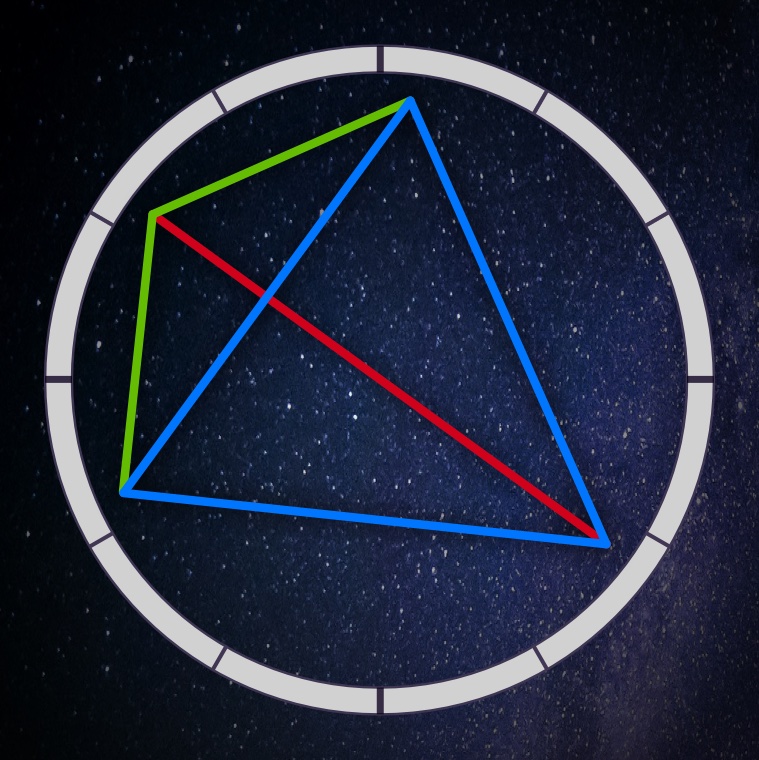
Identifying aspect formations is the first step towards unlocking the mysteries of an astrological chart. Geometric nature of aspect patterns is expressive and symbolic, it reveals an underlying framework behind complex interactions between astral energies of planets.
So many things begin to take shape and make sense once we can “see” them in our mind’s eye. Human ability to see is directly related to the sense of geometry and pattern recognition and as much as we live by numbers, the world of lines and shapes is our true native language.
When it comes to astrological charts interpretations, there are two ways to understand the chart: numerically and geometrically. Some astrologers “drive by numbers” while others tap into geometrical symbolism behind the chart’s “look and feel”. Both methods are valid.
TEASER: The comments section at the bottom has an interesting discussion about Adolf Hitler’s chart and the origins of his evil powers. Good to know!
This story will look into “looking at the chart”
Every chart’s geometry is striking and memorable, it evokes a certain range of unmistakable feelings. The beauty of geometrical approach lies in our near-instant recognition and appreciation of its nature. A numerical description of the chart takes longer to sink into our consciousness.
We do like numbers for their quality of precision and thus base most of our judgement and decision making on numerical assessment. Geometry is the visible side of mathematics notable for its expressive and symbolical power that is able to evoke rich visual associations in the observer’s mind.
Human consciousness exists in the ocean of lines and shapes. We inhabit the world of geometry with its language based on dots and interconnecting lines. We instinctively know how to operate with those principles.
Geometry is about patterns
The visual side of human mind recognises a shape by quickly identifying a pattern that best matches the shape. Our mind works really fast and we take this process for granted: it’s easy to discern every day objects like chairs, tables and trees.
When we encounter an object that we haven’t yet seen, our mind takes time to collect impressions and categorise the newly found entity in order to allocate a corresponding mental “shelf” that can hold this newly discovered item, possibly including similar objects that we may stumble upon in the future.
Astrological patterns and geometrical chart interpretation
The ability to recognise patterns of astrological aspects is the entry point to the geometrical chart interpretation.
Any astrological chart is a complex alchemical mixture of many principles. The astrologer’s mission is to uncover hidden connections between those units of energy, revealing the astral matrix on which the person’s individuality is built upon.
This art of interpretation rooted in the ability to identify two major areas: main chapters and key players.
The chapters are geometrical patterns. The key players are planetary energies that communicate with one another in accordance to the rules of patterns.
Once the initial work on separating chapters out of the chart is complete, the interpretation will begin to emerge as if by itself.
Below is the outline of a method that can be effectively used to visually grasp the chart’s main chapters and key players:
- Relax
- Gaze for some time at the chart’s geometry without trying to make any early or even worse, logical, assumptions. In fact, resist the urge to produce any quick conclusions.
- Take a break and forget about the chart. Don’t worry, your mind will be processing the chart’s image in the background, it is perfectly capable of that.
- Return to the chart observation and begin unpacking its meaning, chapter by chapter. You may want to draw each chapter separately.
By separating basic geometrical patterns and gradually working through each of them, the astrologer is able to identify key driving energies within each chapter continuously adding more details to reveal the bigger picture.
Now that you, the reader, is ready to dive into the patterns, let us suggest that each time you need a refresher about astrological aspects don’t hesitate to revisit our stories that cover major and minor aspects: “Astrological aspects and sacred geometry” and “Minor astrological aspects and the domain of magic”.
The major types of aspect patterns
The visual web of astrological aspects produces many different geometrical formations, some simple others intricate and mysterious. We are going to look at several fundamental patterns, omitting exotic, rare and complex patterns.
Why not jump into the most intricate patterns? The fundamental patterns provide a solid predictable framework for chart interpretation. Exotic patterns are rare, their meaning can vary greatly depending on the planets involved and several other factors. They are both complex and notoriously unreliable. Their alluring nature is the beginner’s booby trap. A truly mature astrologer gets better and more precise results by working on simpler principles.
Choosing a simpler set of tools allows for a deeper immersion and produces a more nuanced chart interpretation. The principle of “less is more” applies to astrology really well.
The seven fundamental aspect patterns presented below constitute the framework that allows to construct other patterns. These seven aspect patterns can be seen as the framework for understanding a complex world of fluid interactions between planetary energies.
Cluster
A cluster is formed by two or more planets being conjunct. Clusters symbolise accumulations of planetary energies, the person is likely to have a strong affinity with that combination of forces and experience strong influences from those planetary energies, especially during periods of transits to that cluster.
Cluster can be quite wide, sometimes spanning across a whole zodiacal sign. In most cases, only the neighbouring planets are truly conjunct while the planets at the extremities of the cluster aren’t in conjunction since their orbs are likely to be too big.
The chart below illustrates differences between a loose cluster of Mars–Mercury–Saturn and a tight cluster of Venus–Moon–Jupiter.
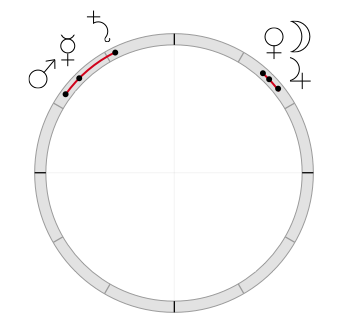
In a loose cluster the extremities are being mediated by an intermediary. In our example it’s Mercury that mitigates between Mars and Saturn that otherwise don’t talk to each other directly.
Tight clusters, like Venus-Moon-Jupiter on the right, result in a much more intense interactions between energies involved. They produce more impulsive gut-level psychological profiles that are more difficult to handle using one’s mind. But the strong factor of irrationality can be turned to one’s favour during certain transits. We will touch on that topic further down.
Cluster vs. satellitium
Satellitium is a traditional term describing a grouping of several planets (more than two) in a sign, or in a house. Modern astrology tends to call it “stellium”, the term that unfortunately obscures the original meaning.
An example below shows two satellitium groups, one Mars/Uranus/Saturn that has no conjunctions and another Venus/Moon/Jupiter/Mercury that has one conjunction, Venus–Moon.
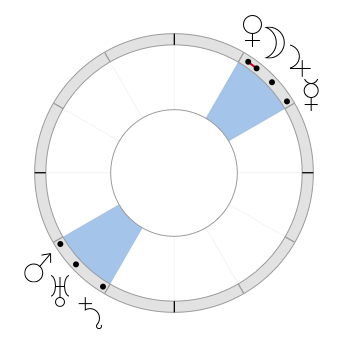
An important difference is that the planets forming a satellitium don’t have to be conjunct, they just need to be colocated in the same sector of the sky. A satellitium is several magnitudes weaker than a cluster since there is no direct connection between the planets apart from them being colocated in the same sign or house.
The word “satellitium” comes from “satellite” or “companion” that makes perfect sense as the planets are companions to each other. The word “stellium” seems to be a new age astrological simplification that sounds sexier (as if related to the stars) but completely misses the original meaning.
Thus we are certainly voting in favour of a clumsier yet more precise notion of satellitium.
Easy opposition
An easy opposition is formed when an “easing” planet is added to the opposition in such a way that it forms a sextile and a trine aspects with the opposing planets.
An opposition signifies polarity and tension between two principles or two planetary energies. In the example below, a Mars–Saturn opposition, when taken on its own, is certain to introduce significant difficulties resolving action vs reason, a need to advance vs a need to retreat. In other words, a typical Mars–Saturn malaise that so often results in fears and locked-up personalities.
But there is help in this opposition. The easing influence of Venus softens the drama of Mars-Saturn introducing a certain element of flow.
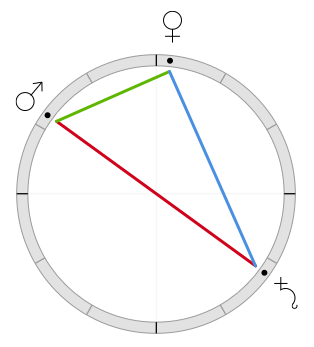
Easy opposition doesn’t mean that the opposition is resolved, it rather provides the person with the third force that can talk to polarised energies.
Easy oppositions provide clues that can help the person to handle inherent conflict in a creative manner that is guided by the easing planetary influence.
T-square
A T-square is a harder form of easy opposition. Being a combination of an opposition and two squares, T-squares point at solid crystallisation of forces and astral patterns in the person’s psyche.
Crystallised sides of personality may equally work for and against the native. In the example below, the Mars–Saturn axis is being “activated” by Venus that is square to both planets. Square is the symbol of manifestation and the material world we live in.
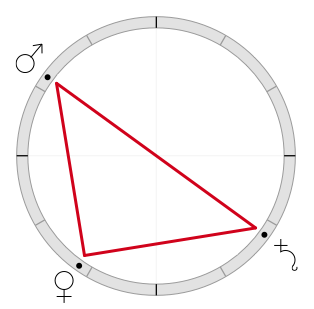
Having Venus equidistant from both planets may result in emotional swings. The person’s emotional state is likely to alternate depending on how Venus manifests itself on a given day. Such oscillations produce distinctly different Venus–Mars and Venus–Saturn sub personalities.
The T-square is an invitation to look for potential emotional blockages that relate to the three planets involved. Once identified and felt, use the power of transits to rectify entrenched patterns. More on that further down.
Grand cross
A grand cross is a combination of two T-squares. This clearly makes it a very powerful pattern that signifies astral crystallisations taken to their extremes.
The example below illustrates a grand cross that is made out of two oppositions, Mars–Saturn and Pluto–Venus, and four (!) squares.
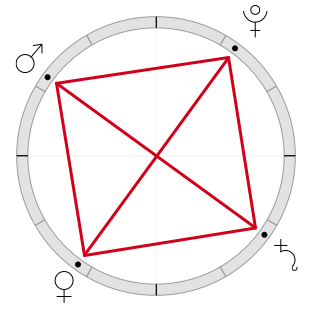
Grand cross is a difficult pattern that requires a good amount of time and attention in order to identify and understand multiple swings between its polarities. The difficulty lies in the intensity of those swings. But once understood, the person gets a real advantage of being able to consciously steer their life.
The grand cross passes an inconspicuous resemblance to the steering wheel. The key to success lies in owning that wheel and thus the destiny.
Grand trine
A grand trine is made out of three planets forming three trines. This aspect pattern symbolises a perpetual flow.
Trines are good for smoothing things out and helping to negotiate or mediate between conflicting or opposing principles. Triangles provide necessary lubrication to the chart.
The big trick with the grand trine is its excessive mediation. In the example below Venus, Mars and Saturn are in constant dialogue that can go in circles infinitely long. We really need to have some red lines here!
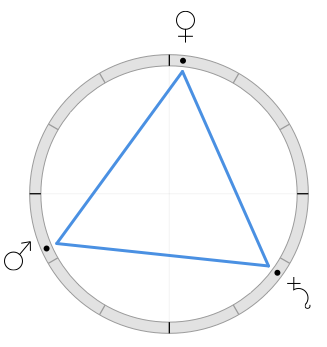
The grand trine is a harmonious pattern that can become paradoxically counter productive in this material world. Grand trine is of great help when sufficiently supported by some concrete manifesting aspects in the chart. Grand trine brings the promise of immense potential provided there’s an action that actually makes things happen in the world, here and now.
Kite
A kite is made out of a grand trine by adding a fourth planet that is opposite to one of trine’s planets. Kite combines the power of trines, sextile and a healthy opposition.
The kite pattern is a more hands-on version of the grand trine. The example below shows how the Sun–Saturn opposition brings much needed polarity and tension that turns otherwise indecisive trine into a powerhouse fuelled by the energy of the Sun and supported by both Mars and Venus that counteract inherent indecisive attitudes of Saturn that often tends to over-think things.
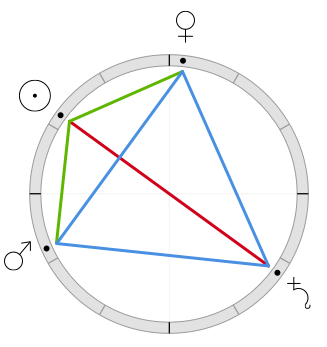
The kite is a wonderful aspect pattern that naturally invites the native to focus on its dominant polarity and use its dynamic qualities while being helped by beneficial trines and sextiles.
Spike
Two similar aspects pointed at a planet form an arrow-like shape, or a spike. Two planets at the base of the spike form a second aspect.
In the example below Pluto is the main planet of the spike formed by two biquintiles (144º) with the quintile (72º) at the base.
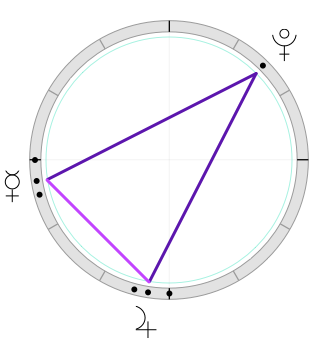
Spikes come in many varieties, although the most powerful spikes are formed by wider minor aspects like sesquisquare (135º) , biquintile (144º) and inconjunction (150º).
The illustration below overlays several spikes to show the difference. The obtuse angle made out of two quintiles (72º) doesn’t produce an impression of intensity and can’t be qualified as a spike. On the other hand, acute angles formed by sesquisquares (135º), biquintiles (144º) and inconjunctions (150º) are reminiscent of sharp astral energies.
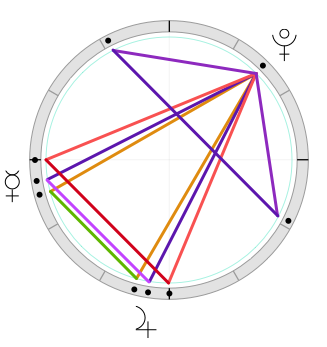
The spike is the symbol of “special” accumulation of forces: special abilities, special karma and anything that can potentially take the person out of the rank of ordinary.
Sesquisquare (135º) spike points at forces of karma relevant to the main planet of the aspect in relationship to the two other planets. It’s not just two sesquisqares but rather a double sesquisquare concentrated on one planet. What’s more, this spike has a square aspect at its base, a sheer smashing strength of this pattern earned it an evocative name of “Thor’s hammer” in modern astrological parlance.
Biquintile (144º) spike symbolises creative, occult and magical abilities. The connection lies in its relationship to the pentagon, the five-point star symbol traditionally related to the ability to make things happen via the magic of sheer will power. Our recent story “Minor astrological aspects and the domain of magic” discussed how star-like aspects are the link to magic and occult.
Inconjunction (150º) spike is also influenced by the magic of number five since an inconjunction is made out of five zodiacal sectors. As the illustration above shows, an inconjunction spike is a close cousin to a biquintile one with only 6º difference between the planets at the base.
Spikes and the “yod”
Some form of spikes were relatively recently popularised as “yod” perhaps to emphasise their hidden and mysterious powers. The word “Yod “ is the name of the tenth letter of the Hebrew alphabet. Traditionally, yod is said to represent an atomic divine quality, a singular point of energy out of which all manifested things came to being. Yod also means “hand” of a man in a prayer, reaching out for God.
Qualifying each spike as a “finger of God” is perhaps a romantic exaggeration that appeared only recently during the New Age. Some spikes do have meaning while others may lay dormant and not do much. It all depends on the overall chart configuration.
Thus we prefer the name of spike over yod. The term spike is more down to earth, covers a wide range of angular formations and doesn’t scream of divine powers.
What intensifies aspect patterns
Any aspect formation becoming significantly more intense when aligned to the angles (the Ascendant–Midheaven axes).
For example, a grand cross aligned with the four angles passes a sense of extreme density and raw manifesting will power.
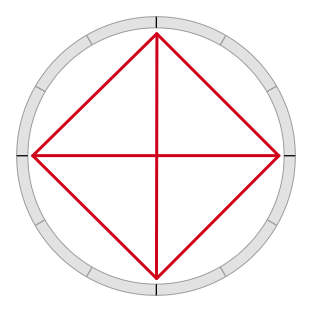
If an aspect pattern rests on the nodal line between the South and North Nodes of the Moon, that pattern points at forces that the individual need to apply to ensure a successful journey towards fulfilment of their destiny.
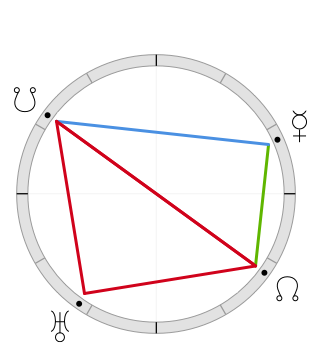
The chart above tells us that using Mercury–Uranus faculties of innovation and originality is the way forward in this incarnation. The Uranus square comes with a warning that any revolutionary faces: the danger of losing one’s head. Introducing mercurial attitude of humour and relativity supplies much needed lubrication to overly electric Uranus. Note that there is a trine aspect between Mercury and Uranus.
Aspect patterns and transits
Having an aspect pattern in your natal chart invites for more careful observations of transits. Such time periods bring significant changes and also allow for rearrangements to take place.
A good approach is to pay attention to transiting planets that match those found in the pattern. For example, having an easy opposition with Venus being the “easing” force can be read as an invitation to watch Venus transits over natal Venus position, as well as the other two planets involved.
Practicing note taking during those periods may prove extremely valuable as you will begin to notice certain repetitions of circumstances around those periods. And this allow to introduce a powerful method for changing those circumstances.
If at the moment of transit you make a conscious choice tangential to usual “default” behaviour, a powerful redistribution of energies may be triggered thus raising the frequency of your chart.
As with many things astrological and magical, it’s all about the timing. Success equally depends on precision and relevance of action.
80 Comments
Char555
Help! I like this article - but most of the illustrations are missing! What am I doing wrong?
Time Nomad
Hey, most likely it’s due to your browser disabled Javascript or some other content blocker. Please turn off blocking or simply try another browser? It seems to be working just fine for me.
char555
Thank you, Denis. I think Java is disabled. I have heard that the “spike” involving biquintiles and a quintile is sometimes called a Golden Yod. Apparently Hitler had multiple Golden Yods, but I think they involved some minor points.
Time Nomad
Yes, you’re making a valid point about Adolf Hitler’s chart. He had two spike formations. A biquintile spike, recently popularised as a “golden yod” wasn’t so “golden” in Hitler’s case. That’s why I am hesitant to use this superlative term because it equally applies to forces of good and evil. Since traditionally gold is the symbol of integrity, we are clearly getting a contradiction here: Hitler was anything but a person of integrity. His biquintile spike points at Moon–Jupiter, a fantastic combination for dealing with crowds, the skill that Hitler was a magician of.
Another is a sesquisquare spike clearly pointing at significant karma with one of its base ends resting on the South Node and another on Uranus. This karmic spike points at Neptune–Pluto conjunction. And this makes a lot of sense since the discovery of Pluto pretty much coincided with the new era of world wars.
Below are Hitler’s natal charts. The chart of major aspects doesn’t disclose much about his real abilities apart from his very strong libido that was equally strongly repressed, a common scenario for dark force initiates.
Char555
Wow, Denis, thank you for all that - fascinating. I must say that you seem to give a lot of information that I haven’t seen before, and I appreciate that. Your style is also easily understandable. As for the missing illustrations, I have discovered that this happens because my default internet program is Internet Explorer, as it’s the only one that allows me to save webpages in .mht format. Firefox works fine, and it does have an option to do something similar now.
Ciara
Do I used asc mc in pattern recognition?
Time Nomad
I’d say use them mildly. The strongest patterns composed of real physical bodies (the emitters or reflectors of light). Geometrical points like Asc, MC, the Moon nodes and other points like Black Moon would be secondary in terms of influence. So yes, they do create patterns but not as impactful as physical planets.
CATALINA EGAN
I recently visited The Eagle’s Nest in Bavaria. It was given to Hitler in 1938 for his 50th birthday. I left with an empty feeling, how such a beautiful setting was the seat where so much evil was concocted. He was just one very evil man who headed a HUGE evil movement.
Martin
It is never one single man - this is just “the marketing” of another agenda of politics that followed. Russia, China, Japanese - they all had concentration camps, gulags etc.
The underlying stream of timequality (seen in astrology) is the substrate that makes it possible for the collective mind to grow such structures that create these “evil leader” - but leader without follower is nothing. It is really needed to look at this transpersonally otherwise - we as humans are likeley to tap into the same issues again and again … look how the didgital Fascism is globally now flooding the world …
Diane
I have both a fixed grand cross on the axes and a double nodal line aspect like the one in the picture, on which Pluto is sextile my NN and trine my SN and Juno is in the t-square formation. My grand cross includes an exact moon/Mars conjunction at the MC, Uranus close to (in the natal chart) and at the AC (in my current relocation chart) Neptune on the IC and venus at the DC (6th house in natal and right on the DC in relocated chart).
I know the grand cross is acting Like a pinball game at times. I feel as if I am in a rest period now but extreme to the point of isolation.
My natal Uranus is square the transit Uranus which is now right on my moon/Mars conjunction at the MC.
Time Nomad
Have been thinking about your chart. The grand cross aside, the Moon–Mars conjunction is the aspect to focus on as the rest of the chart can become much more workable once Moon–Mars is happier.
Moon–Mars conjunction is always a challenge until the native figures out its potential. Their Moon is fiery and can experience burning passion and imagination. On the downside, Mars makes Moon restless. It’s important to find peace without forgetting about the need for engagement — tricky to satisfy the both! A practical approach can be regularly spending a good amount of time walking in nature and feeling the surrounding energies: forests with big trees supply good emotional grounding to the Moon and also feed Mars with the dynamic energy of life. Life in an urban environment is likely to aggravate neurosis in Moon-Mars people. Nature can alleviate the symptoms and even heal.
Diane
Thank you. I did live in NYC for awhile. I liked it but the noise of traffic was highly irritating. I now live alone and have lots of nature–trees, birds, a lake, etc.–right outside my porch, which I live. It is quite peaceful. My moon/Mars conjunction is in Taurus and now has Uranus transiting right on them. Again, they are at the MC in the 10th. When I am with family, I get 9verstimulated by the noise and parties they have. I like being quiet and alone, but I do try to get out with some friends oor at least sit on my porch and enjoy the quiet natural setting.
Diane
And actually I was wrong regarding Pluto and my NNand SN. Pluto is square to both. Pluto is in the 1st house on Regulus and NNin the 4th and SN in Taurus in the 10th. Opposite Pluto is my Juni, so actually I have two grand crosses. One being Pluto, the nodes, and Juni. The other being moon/Mars, Uranus, Neptune and venus. Sounds not too easy for love and commitment? Too much fantasy and obsession, no commitment and lots of changes. Same goes for happiness and money
Dre
Is it only planets that “count” for aspect patterns? When looking at my chart, it is almost exactly like the photo posted under “What intensifies aspect patterns” however mine has Pluto/South Node on the ascendant, Jupiter/Part Of Fortune on the IC, Lilith/North Node on the Descendant, and Mars/Mercury on the Midheaven.
Time Nomad
The angles (Asc/MC) certainly intensify pretty much everything because they are the most time and location specific points of the chart. Positions of planets change rather slowly but the angles move fast and define how the planets distribute across your houses. Can’t see your chart as astro.com expires those images. You better take a screenshot and upload it to something like imgur.
Grace
Hi, it is actually not possible that venus and mercury oppose each other (look at the grand cross➕ ) in an astral chart at least because these two planets are always close to the sun. Am i wrong?
Time Nomad
You’re absolutely right, my bad, Mercury can’t be opposite to Venus. Changed that to be Pluto for maximum drama in tune with current times.
Liz
Although my exact time of birth isn’t known, a chart showing all aspects reveals a stunning and undeniable diamond traced over and over again. I’d love to have to a genuine read to understand the significance
Time Nomad
Do you want to share your date of birth, location and approximate time? I can then put your chart here and make some comments.
GC
Hello Time Nomad. Is a grand cross among Ascendant, Descendant and Midheaven MC, IC intense?
I see these four at right angles in my chart with one degree variation. How much difficult is this please?
Thanks.
Time Nomad
This is due to the geographic latitude you were born at, this makes MC perpendicular to Asc. I wouldn’t treat it as a personal signifier. But I agree, this configuration does look impressive. If you have any planets making significant aspects to the MC, then look at the influence of those planets as they will be extra strong in your chart.
GC
Thank you for replying. Good to know that it is geographic. But I do Have Jupiter near conjunct but opposite MC which is in Sagittarius - seems an opposition..?
Now that you mention, Hygeia near conjunct (1 degree apart) MC in Sag and Juno one degree apart in Capricorn to MC sounds like it’s all about work..?
Thanks.
Time Nomad
So your Jupiter is conjunct to the IC and opposed to the MC - the second major axis of the chart. This gives an extra strength to Jupiter, it has more influence in your chart. It’s certainly a great position, Jupiter brings a good degree of popularity, luck, protection from the powerful people, etc. A lucky planet indeed!
The asteroids on the MC may add some tints but won’t have any significant influence in comparison to Jupiter, they are too tiny.
GC
Merci TimeNomad for replying to the post.
Ace
Love it!
it’s just… look I’ll be blunt, take it or leave it - the tone could do away with speaking “matter-of-factly”. It makes it impalpable to us who treat it as a science and even when things are said nonchalantly, should be given reference to prove the case in point. Otherwise in science you have doctors going around thinking that vaccines have never killed people or caused human harm. Which is grotesquely false and as easily verified as false as seeking to read the published science papers themselves.
We must respect the rule of thumb -all things true lead to source. As else which aim us away from source tend to falsify or elaborate, or insert suggestive storyline which the author believes to be true due to lacking of data and filling in the gaps with that which makes sense to him or her.
Intention may be well - but the results sometimes are catastrophic.
Time Nomad
I describe astrology as a “discipline” and a “symbolic language” thus steering away from the category of science. In science we measure and count something that has hard evidence and can be proven and ideally 100% repeatable. Astrology is way more fluid and doesn‘t follow the hard rules of logic.
This article is a personal reflection on the meaning of aspects as described through the lens of personal empirical observation and deduction of truthfulness or falseness of certain assertions. It‘s about how I as the author experience the phenomena of the aspects.
DOD DC
I have both the grand pentacle and wand of power. What does is the significance? Everyone runs away.
Dan
I have a cluster from 1 libra (jupiter) to 26 Sagittarius (neptune) with all my planets in between. Only chiron is opposite my sun (-2° at 13° scorpio) at 15° taurus, and my nodes at 15° leo (N) and aquarius (S). You mention the benefit of responding irrationally which is shockingly accurate. I also have a difficult time with transits, and its constant. I’m interested in purchasing a reading if thats something you do. Ive had 7 in a year, and all of them have accurately depicted various elements of my personality/past, but none have provided me with any actual clarity in dealing with things like transits. Honestly I feel both blessed, and tragically broken at the same time. Maybe thats my sun square nodes/opposite chiron, but the constant roller coaster ride, and a lack of any squares, trines, or oppositions (im all conjunctions, and a couple sextiles) creating challenges is quite a lot to process.
Time Nomad
Hey, I don’t do much readings these days, simply not enough time! But a quick observation would be your Sun square the nodes and opposed to Chiron. This really hints at the process of transformation that is ruling your current incarnation. Chiron points at the need to heal or simply speaking to embrace your Sun. Once you’ve realised your solar potential that you can meaningfully move into the future. But each of us without exception has a specific challenge in every incarnation. Yours is about embodying the Sun and accepting its incessant drive towards transformation and shining/giving. Your painful transits are just that, an opportunity to break out of the self-constructed shell. It’s your Sun that is working on changing/improving you by challenging you. Only makes you stronger, more complete. It’s a powerful configuration you have. If you take it as a “transform or keep suffering” then things will get clearer, you’ll get a better perspective and perhaps may even notice the moments when it’s you fighting against yourself. Embrace impulses from your higher self and it’ll show the way. But by all means, don’t go blind/fanatical either, apply your judgement at each step.
Tom Davidson
The transits are a way to keep track, metaphorically speaking, which way the “winds” are plowing in your life. They can be ignored, used wisely or abused. Up to you what advantage of the opportunities presaged by each transit.
Phyo Ko
Hi, I’m just a novice to the Astrology with a few days of learning :3 I do appreciate your article, especially your effort. I would like to ask you some aspects in my natal chart because I found some major aspects and some aspects which are not in your chart. (i.e, Cradle & Multiple Planets Opposition) *I’m not interested in Astrology before. But, after facing some unexpected things, I’m deeply focused to analyze myself and my life, I’m in touch with astrology unexpectedly.
With the help of it, I found some answers for my lifetime paradoxes. Meanwhile, my mind is calm, ready to accept unexpected and (I think) I know more about myself (because I feel like ahh, I have a clearer view about myself – strengths, weaknesses, merits, demerits etc.*
It’s a little strange that the more I know about myself and accept the things as parts of mine, my mind is calmer. When I prepare to face my fear and anxiety, I feel like I’m not afraid as much before.
That’s some of my experiences after learning some psychological and philosophical concepts from astrology.
So, I’d like to know some important facts about my natal aspect patterns. I’m really grateful if you point out a little (only if you have some extra times). Here are the aspects of my natal chart -
#1 Stellium #2 (Fire)Grand Trine #1 Kite #1 Grand Cross-Aligned with the Four Angles (?)NN0°-TN29°-Moon2°(?) #1 T-Square #1 Cradle #1 Multiple Planet Opposition
Anyway, thank you very much for the resourceful article Sir. Wishing all the best to you 🙏😊
E-Z
Hello Mr. Nomad! I was curious if you had some thoughts on my kite and spike patterns in my chart. I feel like they’ve really pulled me towards my spiritual/healing work but I have been mystified by the lack of information that I can find on them. Seeing Chiron at the Apex of my Yod seems to have made the healing part of my life a whole life long process.
If you could give me any insight I would greatly appreciate it. My dob is 4/26/1983 9:20 p.m. Kansas City Missouri.
Time Nomad
I’ve had a quick look at your chart and here’s my short thoughts. Generally speaking, Chiron alone isn’t enough to account for spiritual/healing impulse. It may point at what needs to be healed in the person though. On the other hand you have several other much more significant pointers that direct you towards spiritual work. A desire for spiritual work is usually accompanied by a healing desire as well because spiritual is healing in essence. In your chart you have some potent pointers that make spiritual work meaningful: Neptune on the South Node in the 2nd house, Sun in the 6th approaching full Moon (that’s an important incarnation for you, especially taking into account their square to the Black Moon), Saturn-Pluto-Moon in 12th is a very interesting cluster, and tight Jupiter-Uranus in the 1st opposite Venus is a potent group for spiritual work. In the nutshell, you have strong major planetary positions and aspects that support your focus on spiritual/healing work.
Shauna matthews
I’m new to all this astro patterns stuff and it became of interest when I discovered I had so many in my chart.. I enjoyed this article greatly as it was most informative… If’ Not to much trouble could I request you have a peak at my chart… I’m going through alot right now n trying to make sense of it all… August 22, 1979, 3pm, Toronto Ont. Canada.
Kindest regards
Shauna
Elena
Hi Shauna, I’m actually currently studying western astrology and I’m curious to take a look at your chart. I’m also from Toronto! Can you send me a message on Instagram @astroatlas.ca
Joey
Can you explain how the house significations relate to the aspect? Ex: Square relates to 4th and 10th house
Time Nomad
One can look at the values embodied by a specific pair of houses in the light of the aspect. For example, 4th is about the roots of personality, childhood, etc. The 10th is professional area, doing in the world. Those two houses are opposed to each other. If one has planets in both that are square to another planet, for example in the 7th then look how the planet in question creatively challenges (square) planets in the houses. This would alter the feel of each house.
Linda Williams
Really enjoyed your article! Very helpful! Thanks for your work and generous sharing!!!
lynda
I’d like to hear your take on the castle , aspect, my apex point of my castle aspect is the lot of daimon in the 5th, conjunct spica, it is a tight energy, consisting of my asc, desc, pars fortuna, rahu and ketu, it is extraordinarily complex, The castle aspect was brought to my attention, when I looked at the actors birthchart last year, after the filmset accident unfortunately , he has no birth time, reported, but the castle aspect jumped out at me
Time Nomad
Perhaps something along the lines of self definition in the context of progress through time. What one brought from your past influences how they perceive themselves. The me-to-me relationship is more complex than for most other people. That’s my take on that but it’s hard to tell things without seeing the actual chart.
lynda
Self definition through the progress of time, thats interesting, it resonates with me, ive always seen that , but had assigned it to my saturn midpoint sun/moon. Nov 17 1961, 5.25 pm , glasgow, of course as I am just approaching rahu , and ketu, ive not focused on them, but it does magnify the balance ive encountered , when the focus is on daimon in libra, thanks for that
David
Hi, do you have any advice on the Envelope or Double-Kite pattern especially in relation to stationing nodes over a long 3 month period?
Time Nomad
My thinking is along these lines… The kite has a major (opposition) and minor (x2 trines) polarity axes. The envelope has three minor (trine) axes and one major (opposition) axis. First look at the major axis, what kind of planetary forces are involved? What does it mean to have that kind of opposition in your life? Does it create a productive tension or are you getting pulled into different directions?
Once you’ve got that understanding, look at other 4 planets that are trine to the the two major ones. Two trines will bring a lot of movement. It may be helpful if the opposition tends to get stuck (like Mars-Saturn, for example). Or the double trine may unsettle what has been working well. All depends on how you handle your planetary energies.
The lunar nodes will bring up repeating patterns in your life. Could even be your past lives, if you like that concept. The nodes tend to makes us refer back to what we’ve been doing. We may need to repeat the cycle or may pass the “test” and move on to the next evolutional challenge.
Maria Lundstedt
What about the “cradle”?
Time Nomad
The article focuses on foundational patterns that are the most powerful and illustrate the symbolism of aspects. Certainly, there are dozens of other minor patterns that can play roles in specific charts. It’s was my decision not to try to talk about everything but focus on fundamentals instead.
Derek De Roii Alexander
Ive gone over a multitude of calculators and interpretations and I’ve found multiple readings. In one chart i had 5 Yods (spikes), a cradle, a 2 T-Squares, a Grand Cross and Grand Trine… Can you give my chart a look over..?
12/8/1990 23:37:33 Everett, WA, USA
Time Nomad
While this website doesn’t provide readings, I’d focus your attention on the Mars-Moon – Pluto – Sun (T-square). More specifically, the Mars-Moon – Pluto axis is something that you need to understand in terms of how it plays out in your life and what kind of conflicts it may bring. You Mars is very strong, and so is your Venus. Lots of drive that can introduce volatility and major shifts. It’s a chart with a punch indeed.
Andy
Hi Time Nomad,
When I look at my chart I see lots of patterns, including two grand trines (possible Star of David) and two mystic rectangles. There are also a t-square I believe, but there are so many I have a hard grasp of what they mean. Could you give me your thoughts?
May 3, 1990 11:01 am Philadelphia
Time Nomad
The chart patterns may be captivating and evocative yet the most important question is what planets make those patterns? Some patterns may become insignificant because of the planets that make them up. In your case the most interesting is the Sun-Pluto opposition (ongoing transformation is the way forward) and Jupiter-Neptune-Uranus opposition (the generation of fabulous babies).
David
Hi again. I was just wondering if you had a view on what a kite combined with a T-square could be interpreted as? The ‘tail’ and ‘top’ of the kite are the two planets in the T-square that are being squared by the third ‘axis’ planet. Jupiter is the axis planet, and the nodes are the other two.
Time Nomad
A simplified answer is that the energies related to Jupiter (the axis planet) need to be worked on because that relates to the past-future timeline that is governed by the nodes. Jupiter is a nice planet to work with.
Alexa
Hi, as a novice to astrology, how should I better understand/read my chart as, kite(I thought it resembles so)? Or is it grand trine/s? Or bucket?
16 Oct 1978 8.50am Johor bahru, Malaysia
Peter
Greetings Time Nomad!
I have recently been informed of three “yods,” aka spikes, occurring in my natal chart. It was so difficult for me to find interpretations for them together as they form a pentagram. The pentagram, however, is an imperfect pentagram and I am wondering what your thoughts would be on such. It definitely stands out very clearly in my chart and involves major planets with very close orbs.
The past year for me has been both transcendental and overwhelming with a heavy amount of opposing positive/negative events. The discovery of this irregular pentagram is in-line with the spiritual transformation I’ve been going through.
20 Oct 1973 01:25am Plainfield, NJ USA
The pentagram has, at the point, Neptune in 5° Sagittarius 4th house, sextile, on either side, to Pluto at 5° Libra 2nd house and Jupiter at 3° Aquarius 6th house. At the base of the irregular pentagram are, two planets that square the top two side points and sextile each other, Saturn at 4° Cancer 11th house and Mars at 3° Taurus 9th house.
In total the configuration contains 3 sextiles (Saturn/Mars, Pluto/Neptune, Jupiter/Neptune), 2 squares (Saturn/Pluto, MarsJupiter) and 1 trine (Jupiter/Pluto).
I feel like this pentagram, and my just now discovering its occurrence in my chart, is integral to the beautifully positive and light filled spiritual path which I had no idea that my entire life was leading towards (until the personal and worldwide events of this past year), the magnified connection to the collective consciousness which has become very direct for me at times, the role of guide and advisor that has always existed in my life with personal one-on-one instances, but which has quickly been taking on a significantly larger scope of influence these past 13 months, and my complete shutdown at one point due to the overwhelming nature of it all.
The significance of my interactions with many individuals regarding their own spiritual awakenings, since my personal experiences approx a year ago, and their heartfelt gratitude that was expressed when I validated their experiences with my own, at first was intriguing, then becoming overwhelming but now something I feel I am being called to accept as my journey towards my “purpose” in this lifetime.
WHEW, I know that’s a whole lot to take in, boy do I know it, LOL, but I am truly in search of some outside interpretation regarding this pentagram and how it could be relating to everything I’ve been experiencing of late that has been slowly building my entire life starting with the passing of my father when I was only 12. He was heavily involved in many aspects of magic and astrology and had promised to teach me but passed before doing so, which set me on a path that is coming to fruition as my Chiron return approaches.
Ok, I’m done rambling, I promise.
With truest gratitude,
-Peter
Time Nomad
I think your chart genuinely points at a series of changes, perhaps sudden and unexpected to you but they all make sense from the spiritual transformation standpoint. This is your Sun-Uranus opposed to Mars.
There may be certain resistance from your side due to Saturn-Pluto square. Just learning to let go and readjust is an important attitude for a chart like yours.
Your yods also point at Saturn and Mars reinforcing those points.
Peter
Thank you, Time Nomad, for your reply! It is very much appreciated!
Learning to let go and trust in the process, is definitely something I have been finally realizing of late. It brings with it a sense of freedom but also an uneasiness that comes with change and the unknown.
Thankfully, with the strengthened faith that has come from spiritual growth, I feel more ready for what The Universe has in store.
Thank you again!
-Peter
man meteoman
Hello, I would like to ask if anyone has a north link square with venus and pluto and venus with pluto in opposition what does this mean based on what you mentioned in the article???…and a second question if there is a yod boomerang with top of pluto but on the one hand we have 150 and on the other hand 144 what does that mean??? (144 between Saturn and pluto, and 150 exact degrees between pluto and the sun).
Time Nomad
Having Sun-Saturn connected via minor aspects to Pluto could mean a life that goes through periods of transformation. Venus-Pluto would be an active force that impacts life events and choices while Sun and Saturn will be actively challenging that. Venus-Pluto is nice for sex and money but can easily take one astray. Yet Venus-Pluto depends on how Saturn impacts them, it can be blocking things.
man meteoman
interesting answer, the truth is that Venus with my pluto affects personal relationships to an extreme degree. the chronus conjunction measured at 144-145 degrees with the pluto he mentioned in the previous post, what could it mean????….and something a little more general if someone has 2-3 yod boomerangs in these planets does it mean a special “destiny”??? thank you very much!!!!!!
Time Nomad
Minor aspects are dormant until one actively moves towards their destiny. That’s perhaps the simplest definition of minor aspects. They sound magical but only come alive in special circumstances.
The sense of destiny is something that hints at strong Pluto energies in personal makeup. Destiny isn’t a passive principle, it can’t “come” to a person. The person needs to actively seek it through active experimentation. There got to be skin in the game, otherwise destiny remains an abstract academic concept.
A good example of destiny would be the Parsifal character from Wagner’s opera with the same name. Reading the libretto gives a good sense of destiny in action.
man meteoman
Thank you very much for the answers, very informative, well done!!!!!
Emily
Absolutely love that I came across this page. I have quite a few aspect patterns…a cardinal grand cross, 2 yods, a kite (with grand trine), a castle. My yods connect my castle to the grand cross. I have been trying to track transits to the apex of my yod but still struggling to understand it.
My yod is my Moon (2nd house) sextile my Ascendant (conjunct north node) both inconjunct to my Mars in the 7H (which is in my grand cross).
For the last year I’ve been having transit Uranus forming a yod…it’s sextile my Mars and forms an inconjunction/apex to my NN/Asc. It’s been an intense year.
Lately though, I’m very fascinated by how synastry charts activate our patterns. I recently met a love interest and we activate each others yods. The apex’s of our yods sextile each other…forming some kind of a reverse yod on my NN/Asc (and his Mars), which feeds into a grand trine, and also sextiles other planets.
To better explain…
16 degrees Sag - my nn, my asc, his mars 14 degrees Aqua - my moon, his Uranus 18 degrees Libra/11 degrees libra - his mercury/my Jupiter
16 degrees Taurus - his Saturn 14 degrees cancer - my mars
18 degrees Aries - my Venus 20 degrees Leo - his Venus, my chiron
So I have a grand trine with my nn/asc, Venus, chiron and his Mars and Venus join that. And it’s added by the sextiles and forms 3 yods bouncing off each other.
I have no idea what it all means…or how it will manifest. But I found the intersections of our aspect patterns very curious and hope to understand it. Is there even a shape for something like this? 2 sextiles pointed at an apex planet that forms a grand trine and inconjuncts 2 planets that also sextile each other and inconjunct the other sextile? Haha. (Apex planet here being my Asc/NN in first house conjunct his Mars in 10th or 11th house. I only know he’s an Aquarius ascendant but not the degree to determine which house his Mars falls into. But I have a feeling given this points to my NN in 1st house that this one isn’t gonna end in a relationship even though it’s significant….to be determined!)
Ps…no idea how to work with my own aspect patterns. Yod on my Mars in 7H inconjunct my NN and Moon and mars as part of the grand cross is kind of a mess. I basically keep having major conflicts with people to force me to stand up for myself and all i want is friends and yet every time I make them I’m forced to battle them and stick up for myself. My friends and lovers always become open enemies. Like seriously I think I’m being a loving cancer and next thing I know I can’t go out in public because they’re screaming swear words at me. It’s not fun haha. Before I discovered astrology I kept thinking I was doing something really wrong and that the solution was to make myself small and quiet and agreeable. But the fact I keep getting fed clear moments where I have to defend myself, people being very cruel, it just makes me think that being quiet and agreeable isn’t working. My discovery of my NN in 1st house, and a yod on my Mars in my 7th makes me wonder if the path to healing is actually to step into these battles and choose myself over keeping harmony. But my chart ruler is Jupiter in libra….so that’s really hard to accept. Ah the grand cross. Didn’t even get into that… Venus square Neptune and mars, Mars square jupiter opposite Neptune, jupiter opposite Venus.
To all us grand cross folks…thinking of you. Hopefully we can all help each other find our way.
Time Nomad
Patterns like the grand cross not only looking impressive, they actually reflect an accumulation of significant astral energies in person’s astral body. Sometimes it works for them, other times against them. The main thing to remember is that once connected by significant aspects those forces are never dormant, they are active and loud.
The grand cross you’re describing is the driving force for many situational patterns. Venus, Mars, Neptune, Jupiter dynamics effectively create “push and pull” kind of volatile scenarios where one would oscillate between idealism and fighting. The Moon doesn’t like that kind of stuff and naturally gets hurt.
Should one shut down their sensitivity and become a fighter? The risk is the loss of the Moon’s fluidity and the power of insight.
Getting endlessly hurt isn’t a piece of cake but there’s a possibility of staying vulnerable and open while letting things go if needed. And there could be a lot of those “just let it go” moments. When one is easy with letting go, a lot of otherwise aggravating situations won’t even happen. The higher wisdom works wonders.
Bee
This was such a good read! Thank you for sharing with us. I have a few patterns that I’m still trying to figure out; a castle, cradle and rectangle. I also have a water grand trine, spike & a t-square. If you have time, I would love to hear your perspective on them!
Time Nomad
There’s plenty of aspect patterns indeed. Not all of them have a significant influence – that’s due to the actual planets involved. A good way is to look at each aspect in a pattern to see how those energies may interact with each other. Patterns as such are hard to be conclusive about, it all depends on the ingredients.
Cher
Hi TimeNomad,
Almost my whole chart is build on ‘golden yods’. all 5 yods within 3orb. It’s so hard to figure out where to focus bc they’re all over the place. The 12th house is the most shared place. Do you have any suggestions or advice for having so many Yods in general?
Thanks for the read, really enjoyed it.
Time Nomad
The 12th house is the house of transformation. That can give you a direction of looking at the transformed (higher) modalities of the planets in that house, especially if they are “pointed at” by the yods.
Generally, the 12th house invites focus on deepening one’s understanding of life and exploring the spiritual dimension of oneself in a quest for ongoing transformation.
Juana
Hi, I’ve always been interested in finding out the depths of my birth chart. The more I understand, the more life gets easier. I have been really looking forward for a place where my questions can be answered. First of all I have a Rectangle shape, and I wanted to ask you if there’s anything you may know about it. My second question is how Grand Trine with T-Square and Grand Cross combined are affecting my life? Is there anything unusual that I might have overlooked that could help me? Thank you so much for listening me out. I’m amazed by the way there’s already so much information in this article. This stuff is really interesting.
Time Nomad
Astrological aspect patterns constitute what is referred as “chapters” within one’s personality. The way to look at them is to write down each planet of the pattern and see how the planetary forces may interact with each other. Ignore the Moon nodes, they aren’t exactly celestial bodies, that may simplify understanding. It’s fine to add the nodes later but that would be counterproductive in the beginning.
The geometry of the pattern will give you and idea how those planetary energies relate to one another. You can lookup the qualities of aspects (conjunction, opposition, square, etc) to get basic ideas.
Ana Monique
I have a Green star in my birth chart. My chart is just weird can someone explain the star and what it means.
Time Nomad
Not sure what that could be. Can you please use the “Contact developer” in the app (under the top left corner cogwheel icon) and send me some screenshots?
Ella
Hi Time Nomad,
I am looking at my friend’s natal chart, and its interesting how her chart consist of mainly Grand Trines, about 7 of them with just a single Square. Is this chart really rare? She’s a really good natured person and so far her life as been smooth sailing, I see lots of potential in her 10th house with the earthy clusters and satellitium in virgo, but she’s not particularly career focus or ambitious.
Time Nomad
That’s the thing with the trines — they are good for the flow but not good at manifesting things in the physical world. To be ambitious and creative one needs squares, oppositions and a bit of conjunctions. And a good placement of Saturn — it’s hard to do things without Saturn that works as opposed to blocking the flow.
But the trines are good for activities that involve holding and nurturing people. It can be things like counselling, psychology, etc. — the caring aspect
Jessica
I came across this article and comparing my chart to the pictures above mine is way different I have 5 planets in my 5th house 2 in my 6th house and 2 in my 4th house. I’m trying to understand my chart better to understand myself better. I am open to hearing anyone help with some insight Bday is 09/01/1980 born 12:02 am.
Time Nomad
If there will be volunteers to look at your chart, they will also need your place of birth.
vahuma
hi thank you for your information, I learned a lot from you. ^^ and if you may help I have two questions.
1 I have 2 T-squares in my birth chart:
the question is: can this be considered as a grand cross? ~~~
2 I have 2 spikes in my chart (however, they are like what I saw in my childhood)
I wonder if they have a meaning or not.
will you help me?
Time Nomad
If the Moon isn’t conjunct to Mars then it’s probably not a grand cross. The spikes don’t look significant as they aren’t composed by major planets. The Moon nodes and minor planets don’t add much punch to more subtle patterns like the spikes.
The Saturn-Mars-Neptune formation is perhaps more important than the other things. There’s an invitation to challenge own doubts and procrastination and possibly fears — in an active and constructive manner like taking on certain projects that require judgement and discernment and actually completing them.
vahuma
and sorry I couldn’t upload my natal chart.
H
Mystic rectangle wasnt covered here but I have a question - in my chart, I have MC at 20 Libra, Vertex & south node at 21 & 19 Leo, IC at 20 Aries, and Moon & north node at 19 Aquarius. Since I am using my MC IC and nodal axes, does this still count? alternatively it can be MC, Vertex, IC and Moon… I’m not sure what can and cant be used… if we then incorporate major asteroids and so forth all the patterns will emerge! Also, I have sun 12 sag, and moon 19 Aquarius both 66 apart and at 147 to Chiron in cancer - this is a yod/ spike right? since its a biquintile with 3 orb
akbar
hello I am a student of financial management. for a research work in the field of financial astrology I need the data of planetary composed aspects from 20/03/1991 to 30/09/2024. Please guide me how to download the data in excel file format. best regards
Time Nomad
The app wasn’t designed for bulk data export. What you need is a some kind of a statistical research tool. Personally, I don’t know any specific software that I could recommend.